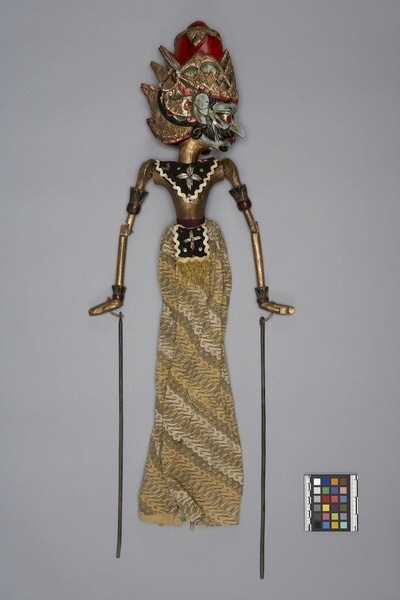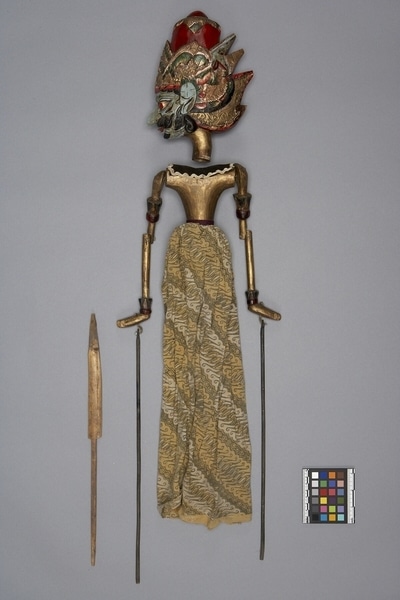Rod Puppet Item Number: Ib382 a-c from the MOA: University of British Columbia


Description
Three-dimensional male humanoid puppet: large head (part b) fits into body with skirt (part a), and a control rod (part c) with a long shaft that passes through the body and fits into the neck of the figure's head. The body has jointed arms, each with a long controlling rod attached. Blue face (Bima type) positioned slightly downwards; wedge-shaped nose, bulging white eyes with red irises, closed red lips. Teardrop-shaped red decoration on each cheek. Thick moustache, beard, sideburns, hair in black. Very ornate crown (mahkota) in red with gold diadem, karawista with green trim. Gold sumping in green and red, above black Tali Garuda. Double badong beneath grey Garuda Mungkur (short-tongued) with siyung jawi. Considerable discolouring of head and torso. Neck and upper body dull gold, each arm with black and red (?) ornaments at wrist and bicep. Hands held flat and bent back at wrist. Black chest covering and apron with cross-shaped wrapped wire designs, white wavy trim, sequins. Apron has purple waistband, and worn yellow fringe at bottom. Long batik skirt in yellow, beige and green.
History Of Use
Javanese puppetry as an art form probably developed by the 11th century. Wayang golek puppets of western Java appeared during the 16th century. Originally the plays depicted Javanese mythology, but after the Indian conquest of Java the Hindu epics, Ramayana and Mahabharata, were incorporated into the cycles, which comprise about 200 plays. A dalang (puppet master) performs the plays to celebrate important occasions, usually in three acts, with vocal and instrumental accompaniment. Typically they serve a moral and religious purpose, and more recently, one of political commentary. Important puppets often have several manifestations to denote changes in age or disposition. Boma, known also as Sutija and Bomanarakasura, is the son of Kresna and Pertiwi. He is a great prabu (king) of the Mahabharata cycle of plays, which depicts the conflict between the Pandawa brothers and their usurpers, the Kurawas.
Cultural Context
Theatrical performance.
Iconographic Meaning
Each puppet is characterized by its wanda, a Javanese word which describes the specific mixture of elements of size, form, colour, ornamentation and carving. Blue face indicates calmness or spiritual awareness; red irises suggest anger or assertiveness. Large facial features and body not considered refined. Batik skirt, arm ornaments, and position of hands indicate refinement and rank, as does Garuda Mungkur. Mahkota (crown) found only on prabu (kings). Configuration of headdress and face identify character as Boma (or Sutija); however, small differences from the standard exist. Puppet has less exposed hair, and closed mouth. These differences are minor, although they may imply the puppet is a variation for a particular play or mood.
Item History
- Made in Java, Indonesia
- Owned by Donald Bone before January 4, 1980
- Received from Donald Bone (Seller) and Museum of Anthropology Donations Fund (Funding source) on January 4, 1980
What
- Name
- Rod Puppet
- Identification Number
- Ib382 a-c
- Type of Item
- puppet
- Material
- wood, cotton fibre, fibre, paint and metal
- Manufacturing Technique
- carved, painted, tied, woven and sewn
- Part A
- height 60.5 cm, width 23.0 cm, depth 7.0 cm
- Part B
- height 22.0 cm, width 8.0 cm, depth 17.0 cm
- Part C
- height 38.2 cm, width 2.0 cm, depth 1.0 cm
Who
- Culture
- Sundanese
- Previous Owner
- Donald Bone
- Received from
- Donald Bone (Seller) and Museum of Anthropology Donations Fund (Funding source)
Where
- Holding Institution
- MOA: University of British Columbia
- Made in
- Java, Indonesia
When
- Ownership Date
- before January 4, 1980
- Acquisition Date
- on January 4, 1980
Other
- Condition
- fair
- Accession Number
- 0586/0001 a-c